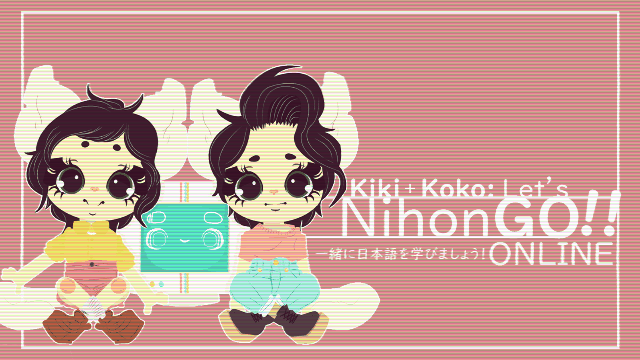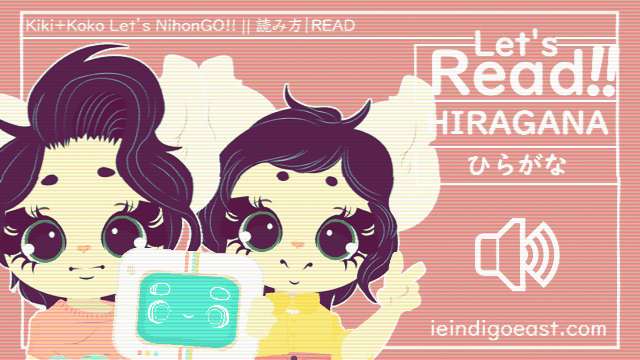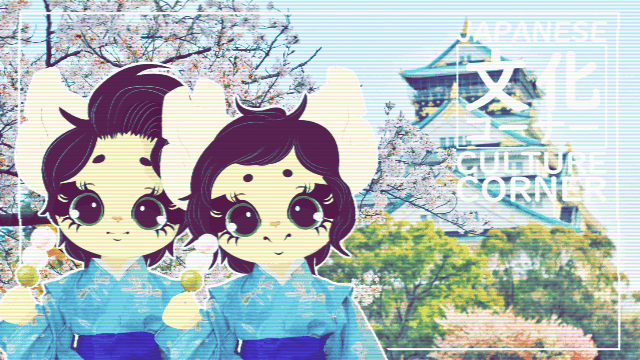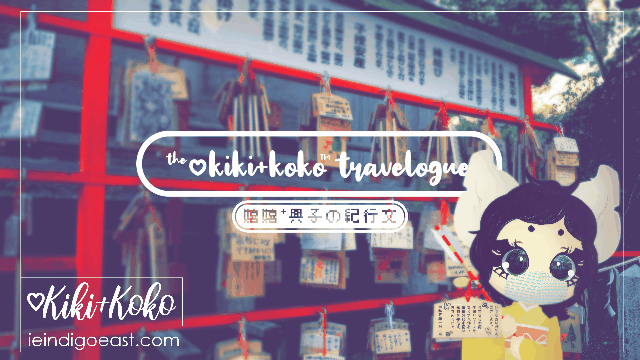皆様, こんにちにゃあぁ!Welcome to Kiki+Koko: Let’s NihonGO!! Online, the fastest growing blog on The Internet that’s run by cat-like alien twins and a computer robot! When you find yourself out there, all alone, trying to survive in Japanese language, identifying words is important. But, sometimes, if you’re just trying to survive, you may think you can get by simply understanding the gist of a word, the sounds you’re hearing. But, what about when you’re hearing very similar words? Sometimes, it’s not about the sounds you hear, but about the sounds you don’t hear that can help you. When you’re using the word, you have to be sure you’re positioned just correctly, when you’re hearing the word, you have to identify what you’re not hearing. Identifying between two words could save your life… of Japanese language learning.
We’re Kiki+Koko, your guides to Japanese language and culture, leading you through the brush and helping you navigate through the twisting path of Japanese language so you can enjoy the beauty of the landscape! Usually, when we have a lesson focused on reading a character, it would focus on how it sounds. But, in this case… it’s about how it doesn’t sound! Well… Okay, it’s about how it sounds, but we’re going to go through this step by step so it should be a lot easier to understand.
つ+っ: ‘Don’t Talk To Me Or My Son Ever Again‘
Similarities and differences between つ and っ
You may recognise this big guy from the previous 平仮名, hiragana, lesson: 「たちつてと」See, there he is in the middle:「つ」. He’s looking as lovely as ever, and he makes a special sound, a sound different to anything found in English. But, that’s covered extensively in the linked lesson. He’s part of the main 五十音, gojuuon, but as you’ll discover, the main Japanese ‘alphabet‘ is far from complete with the gojuuonjun. There are many more, but one that makes two halves of a melon, a chip off of the ole block. It’s the son of 「つ」: 「っ」.
You might already be able to suss out the difference between 「つ」and 「っ」. Hint: 「っ」is smaller— which is a helpful hint as they look exactly the same otherwise. But, what does this ancient historical meme have to do with this? Well, 「つ」and 「っ」may look the same, but they definitely don’t sound the same. In fact, it’s not about what 「っ」sounds like so much as about what it does.
What Do You Do, Little Tsu?
The function of っ
So, while we’ve emphasised the importance of learning how to read Japanese, we’ve also acknowledged the helpfulness of romaji. And, in this case, it’s much easier to illustrate the function of 「っ」 using romaji.
Basically, what we’ll call ‘little tsu‘ for this section, doubles the consonant of the character after it. Here, we’ll show you two words you wouldn’t want to misuse. Let’s say you see a child carrying a musical instrument: 楽器, gakki. Simple enough, but let’s say you point to the child and say: どんな餓鬼ですか。donna gaki desuka. So, while you meant to ask what type of instrument it is, you accidentally asked them 「what kind of brat are you?」
Now, realistically… they probably will assume you misspoke. But, in a worse case scenario, their parent would shield them from your rudeness. Always prepare for the worst.👌 But what went wrong? Let’s take a look at what little tsu would have done for you:
がき = gaki
がっき = gakki
So, it’s a lot clearer in hiragana that there’s a big difference between the words. When you place little tsu before any hiragana with a consonant sound, it will double the consonant when romanised. And, sure, that looks different, but what does doubling a consonant do?
Find out all of this and more after these messages:
The Sound of Silence
Hear our words that we might teach you… how to pronounce Japanese geminate consonants
So, knowing the linguistic terminology of a ‘geminate consonant’ probably won’t make or break your survival in Japanese language, but if you’re interested in linguistics, it may assist you in pronunciation.
But, what sound does 「っ」make? This sound, or lack of sound, is something that can oddly be better described than heard– Well, it’s best to understand what’s happening before trying to suss out what you’re hearing.
Basically, 「っ」acts as a blank space between morae, like hiragana characters, with no sound, like an extra beat in the measure, a gap, a brief pause. This sound occurs quite often, and it may feel very different at first, but it’s definitely worth getting a better understanding even for those looking to only dabble in Japanese. Learning a language is all about understanding and communication. So, making sure you communicate correctly is paramount. Let’s take a look at a few examples where this may cause a bit of a mix up with character’s we’ve already learnt:
来た = きた = kita → arrived
切った = きった = kitta → cut
秋 =あき = aki → autumn
悪鬼=あっき= akki → evil spirit
猫 =ねこ =neko → cat
根っこ=ねっこ=nekko →root
Of course, context can solve conflict, but if you’re learning, it’s always best just to try your best and match pronunciations. There are already so many homophones that leaving an entire character out of a word’s pronunciation would just make things difficult for everyone. In each of these, all you need to know is the sounds of each of the characters, but in the simplest way of explaining it, you simply put a gap betwixt the two characters. This would definitely be important in many cases:
If you’re on a nature walk with the first signs of autumn arriving with the warm reds and oranges of the leaves and the chill in the air, but suddenly, you come across a spooky ghost and you need to warn your friends! But, you forget the little tsu, and you say: 「秋が来るのよ!」aki ga kuru no yo! Autumn is coming!! Then, they’ll sigh, look up into the trees, and agree. But, whilst they admire the change in the trees, they’ll fall victim to a land developer in a mask and the masked person will have gotten away with it, too, because of the lack of meddling kids, and the lack of little tsu. And, let’s not even get started with the mix ups between neko and nekko that could end up in a horrific incident. But, no worries, we’ll lead you through some ways to drive this pronunciation difference home.
Let’s use some English words as an example of when you might hear a similar phenomenon. Now, we’ll try to adapt this for most English speakers as there’s many pronunciations of the same words, but it should still be something you’ve heard or experienced. Let’s use a more extreme scenario and think of Cockney accents. Though slowly going extinct, the general idea straggles on in the East End.
Think of the word ‘butter’ or ‘better’. In many accents, you’ll hear just a glottal stop betwixt the two vowels. This is very close to the sound of the little tsu even if it’s different than the function. If you can emulate that, you’ll be much closer.
But, again, it’s not just for British dialects; for many dialects of English, this phenomenon applies. Think of words like: bat, cat, rat, that. Now, some more posh people might pronounce the 「t」at the end, but in spoken English, it’s very common to hear nothing but a blank stop of air. This is a good time to say it aloud with the very conversational tone: mat, sat, pat. And, even if your tongue does move to create the 「t」, it’s often not very audible unless it’s almost whistling through the front teeth.
With all of these examples, we can return to our initial prompt: What is 促音, sokuon? This occurs using little tsu, and it may make more sense in kanji now that there’s more context. 促, soku, means press, urge, or prompt as 音, on, means noise or sound. It’s like you’re prompting your mouth for the next consonant for a moment. So, while it seems like a mysterious silent character, it’s all about what is happening around the character that matters.
We hope that this helped you understand and equip the new survival tool that is 「っ」. If you need further assistance wielding and differentiating, feel free to leave a comment below. We want to make sure you have the best opportunity to survive and thrive in order to truly have an enjoyable experience with Japanese language. But, if you want to communicate, reading and writing are other essential tools to your survival. We’ve covered the first 46-48 hiragana as of this lesson and shall continue, so be on the look out for the latest lessons in reading, writing, and recognition.
If you want to make sure your Japanese language survival kit is stocked with the latest tools, you can make sure you stay up to date by subscribing to the Electronic Mailing List of Tomorrow, today, found usually at the bottom of the site page or the sidebar on desktop. You’ll get the latest tools and resources to surviving in Japanese language in straight to your inbox. That’s articles, videos, podcasts, and more.

Grooving to the content we’re creating? You can leave a TIP in the TIP♡JAR to keep it going!
(Can’t? No worries! The content is free for everyone! We’re just glad you’re here!! Bring friends if you like~!)
Also, we want to make sure we can continue to offer this and even more content for months and years to come. But, sadly, advertising alone can’t cover the cost of running this site and surviving with food and shelter. If you want to ensure our survival as well as the continuation of the creation of new and even better content, feel free to leave a TIP in the TIP♡JAR to keep it going, or for long term contributions in increments, you can join our Patreon where our gracious host, Indigo East, usually posts behind-the-scenes, sneak-peeks, exclusive content, and more. And, we join in as well! Again, if you’d like to support our survival and the creation of more content to be made available to as many people as possible, you can also share the content! You can easily share via Twitter and Pinterest where you can retweet and repin respectively without even having to type! Gestures like that go a long way, and we appreciate it.
Thank you for joining us! We hope that you continue with us on this adventure, and we appreciate that you’ve chosen us to assist you on your Japanese learning journey!




























10 replies »